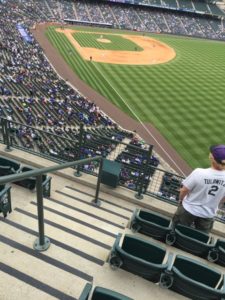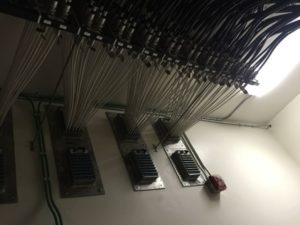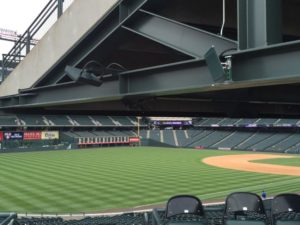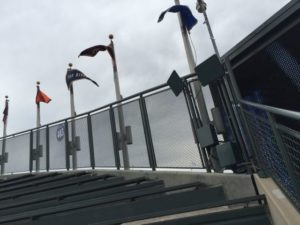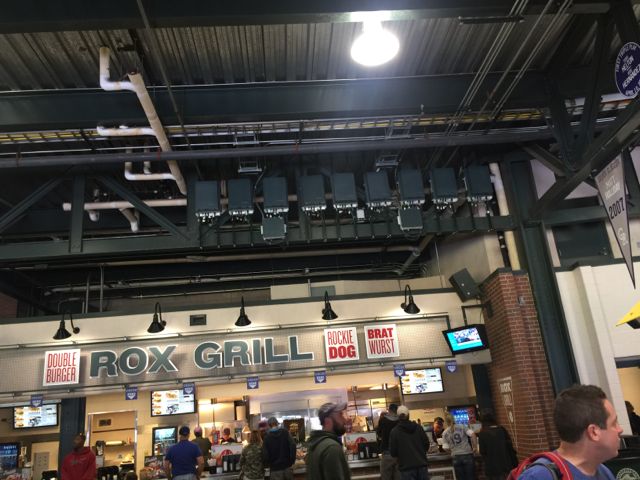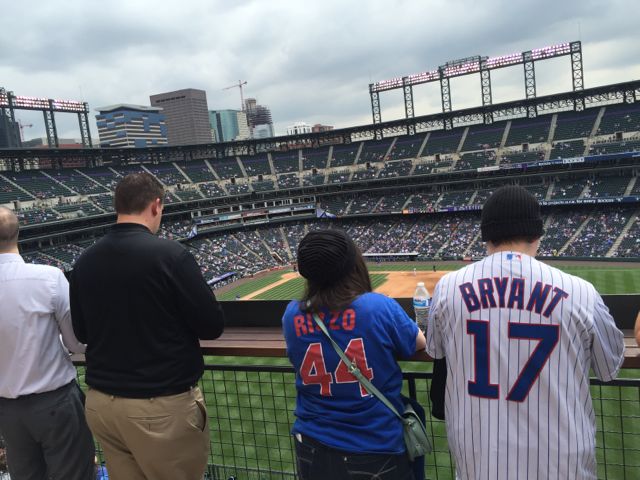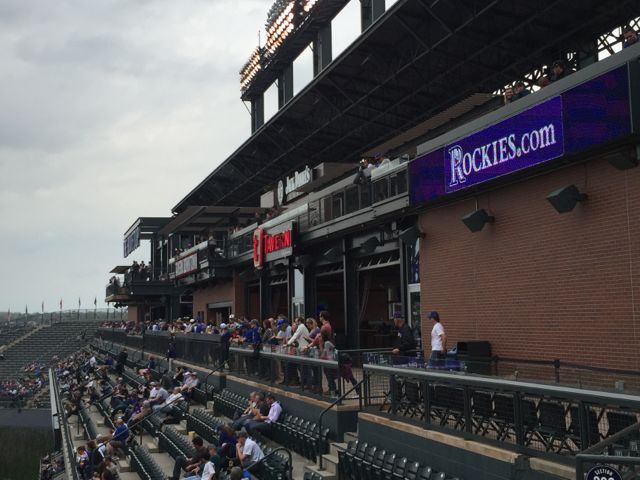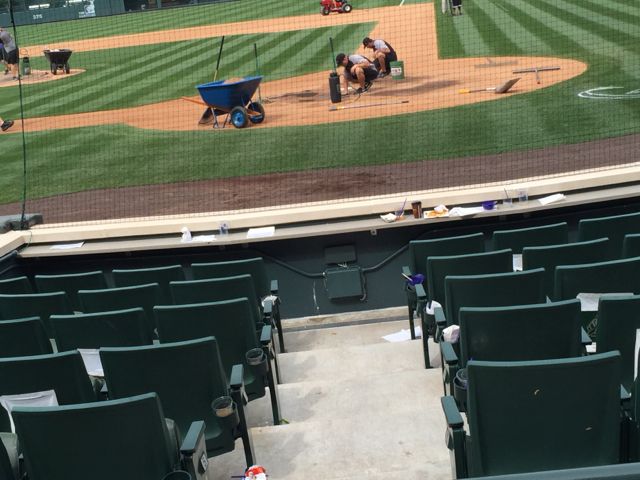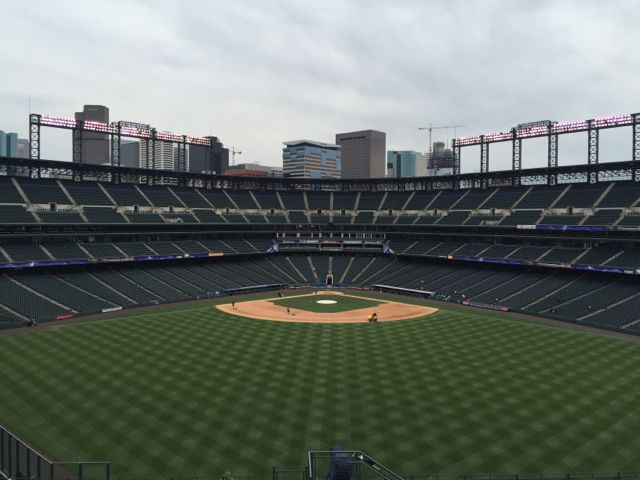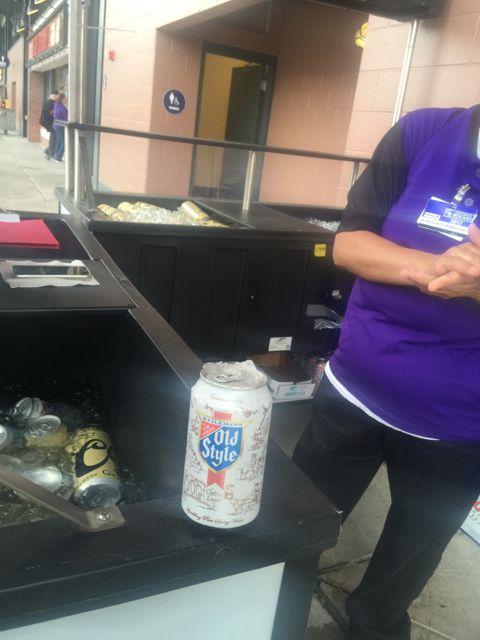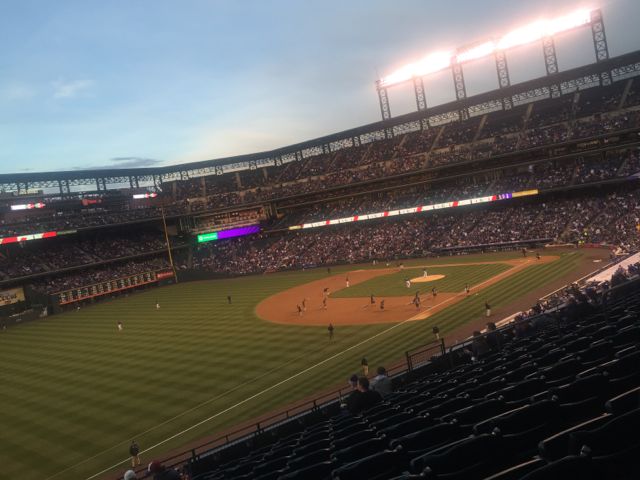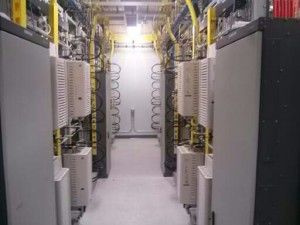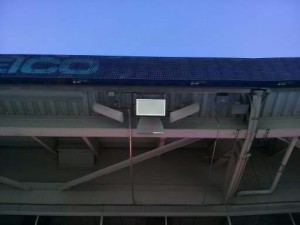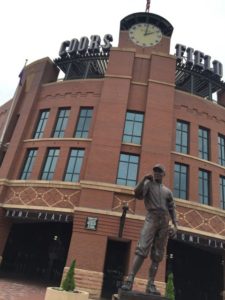
The main gate at Coors Field, the third-oldest ballpark in the NL. Credit all photos: Paul Kapustka, MSR (click on any photo for a larger image)
Opened in 1995, the brick-and-steel venue in Denver’s lower downtown has another oldest-type attribute, in the fact that Coors was one of the first MLB stadiums to get a Wi-Fi network built for it by MLB’s Advanced Media arm, a deployment that went fully live in time for the 2015 season. Like its bricks-and-mortar host, the “old” network is still doing fine, even if it was built without some of the newer technology and techniques that have appeared in stadium networking in the lifetime of the past couple years.
With an opening-day Wi-Fi data total of 2.2 terabytes used, Coors Field’s Wi-Fi network is more than ready and able to handle any increases in activity that may or may not be related to the Rockies’ resurgence on the field, where the purple players have spent most of the season so far in playoff contention.
During an early May visit, Mobile Sports Report found the network performing strong throughout the venue, with many 60+ Mbps readings for Wi-Fi download speeds in all seating areas as well as on heavy-traffic concourses. What follows here is some history of the park and its role in the MLBAM Wi-Fi rollout, as well as our random speedtests from a visit during a doubleheader with the defending World Series champion Chicago Cubs, whose well-traveled fans add to the capacity in any ballpark where the team happens to be playing.
One of the earliest in ‘downtown parks’ resurgence
Editor’s note: This profile is an excerpt from our latest STADIUM TECH REPORT, our Summer 2017 issue that has in-depth profiles of network deployments at the Atlanta Braves’ new SunTrust Park, new Wi-Fi for Westfield’s Century City Mall in Los Angeles, and a profile of a new Wi-Fi network at Red Bull Arena. DOWNLOAD YOUR FREE COPY of the report today!
A little personal history for yours truly intersects with the origin of Coors Field — way back in 1991, I was one of the lead baseball writers for the Boulder (Colo.) Daily Camera, and our main story that spring was the question of whether or not Denver would land one of the two NL expansion franchises soon to be awarded. Like many other cities and regions hopeful for pro sports, Denver and Colorado voted for a tax that would help build a new baseball-only park, which looked great in those artist-concept sketches that are always floated around.But for me what really hit home was when the team behind Denver’s bid actually went out and chalked out a baseball field in the vacant lots where Coors Field would actually sit, among the old brick warehouses in the city’s lower downtown neighborhood. On the day of the official National League visit, there was even a group of kids playing baseball on that field — whether it was staged or not, the presentation was cool, and it probably stuck in the minds of many others like it did in mine, that a downtown park would be a great thing in Denver.
After being awarded the franchise and playing a couple years in the old Mile High football stadium, the Rockies finally moved into their new home for the 1995 season, in a building inspired by Orioles Park at Camden Yards, the downtown venue built for the Baltimore Orioles a few years earlier. My first impressions at the time were favorable, noting the wider concourses and seats tilted to the action on the field, along with a ballpark brewpub as being good trends for others to imitate.
Fast forward 20 years, and at Coors Field, lots has changed from the fan perspective. With personal digital devices everywhere, and fans wanting to use social media to share experiences, the home of the Rockies is no different from any other large sports or entertainment venue in needing solid connectivity. As perhaps befits the pro sport with the best digital league-wide plan, MLB’s advanced media arm (MLBAM) in 2014 embarked on a program to make Wi-Fi and DAS deployments happen in every stadium that didn’t have them (or had older. underperforming networks). By cutting deals with carriers and equipment suppliers and teams. MLBAM put together $300 million in the kitty for a buildout that reached 23 stadiums by this year’s ASG.
(Some teams, like the San Francisco Giants at AT&T Park and the Atlanta Braves at new SunTrust Park, have opted to build their own physical networks, even while working closely with MLBAM on matters like the league-wide Ballpark app.)Coors Field was among the very first in the MLBAM buildout efforts, with fan-facing Wi-Fi available in time for the 2015 season. Though its buildout predated some of the newer techniques and technologies used for stadium Wi-Fi deployments — like under-seat or handrail-mounted Wi-Fi APs — our tests showed the Coors Field Wi-Fi network, which now has approximately 550 APs, to be as strong as any we’ve tested, with signals in the 60 Mbps download range throughout most of the park. We didn’t test all the DAS carrriers but from all appearances, AT&T, Verizon and T-Mobile are well represented on the AT&T-built cellular network. According to AT&T there are 322 antennas in the newer version of the DAS, also built in 2015, which AT&T said has roughly six times the capacity of the previous network.
As the Rockies enjoy an on-field resurgence (Colorado was in or near first place in its division through most of the spring and remain in the wild-card hunt as of this writing), fans should be happy to know their connectivity is competitive as well, with both team IT types and MLBAM keeping an eye on keeping customers connected.
Deck locations help ‘front to back’ work well at Coors Field
With three main tiers of seating, the 50,398-seat Coors Field has plenty of overhangs to work with as antenna mounts, making the so-called “front to back” design philosophy work well. Michael Bush, senior director of information systems for the Rockies, led us on a tour of the stadium, noting that at the tops of most seating areas there were two antennas, one pointing straight down and a “Gillaroo” panel antenna pointing down the rows of seats.
At the bottom of most seating areas, including close to field level, there are Wi-Fi APs mounted either on the playing-field walls, or on the railings in the upper decks, pointing back up the rows of seats. In section 131, right behind home plate, we got readings as high as 63.10 Mbps on download and 48.75 Mbps for upload, almost exactly halfway between field level and the concourse at the top of the lower bowl.In row 16 of section 138, behind the Rockies’ dugout, we got a speedtest reading of 63.32 / 41.63 Mbps, and in the outfield seats behind the left-field foul pole we saw speeds of 68.29 / 49.66 Mbps. Up in the “Rockpile” seats, way up top in straightaway center, we still got a Wi-Fi mark of 66.69 / 41.44 Mbps, probably from one of the four antennas we saw mounted on the back-side railings.
In the back of the walk-around “Rooftop” club and bar area in the upper deck of right field we got speeds of 61.21 / 28.86 Mbps, and then marks of 61.52 / 40.53 Mbps when we moved around to the front of the Rooftop, where you can lean on a railing while watching the game below. The lowest marks we got were in the upper deck of section 317 along the first-base line, where the speeds were 42.16 / 25.33.
All of these tests came during a break between games during a doubleheader versus the Cubs, when the stadium was cleared between games. The marks also varied between being on the main Rockies fan Wi-Fi SSID, and one reserved for Verizon Wireless customers, which our device kept autoconnecting to. But even as the stadium filled up for the nightcap, our signals stayed strong, including a 67.62 / 29.78 Mbps mark up in section 342, in the upper deck along the third-base line.
On Verizon’s LTE network we got a reading in the left-field bleachers of 14.99 / 15.19 Mbps, and a reading of 11.26 / 7.69 Mbps up in front of “The Tavern,” one of the bars in the Rooftop area. We did not have devices to test cellular signals for AT&T or T-Mobile, both of which like Verizon are also on the stadium DAS. Sprint, according to Bush, serves its Coors Field customers with a macro antenna deployment on a rooftop across the street from the stadium along the first-base side.
In our tour of the venue, Bush led us down to the head end rooms, where the DAS deployment looked military in its precision and organization. He also pointed out the cooling vents, which went from field level through the ceilings to finally pop out above the concession stands on the main concourse level, out of view for anyone who wasn’t trying to look down to see them.Though Coors Field’s lower level seemed to have more than enough room for head end rooms, Bush did show us the parking lot “shed” that MLBAM built to house its video operations, including the on-field replay system that shuttles signals back to league headquarters. There is also some Wi-Fi coverage outside the building, mainly in the north parking lot which doubles as an area for media tenting for large events like postseason games. But for the most part Bush said Coors Field is careful to limit its Wi-Fi footprint to the facility’s walls, so there isn’t any bleed-over use by the residential and commercial buildings that are just across the street from three sides of the stadium.
Making sure the tech fits the park
As one of the first MLBAM deployments, the Coors Field network might have been excused for being more functional than aesthetic, but as our visit showed the opposite is true. Unless you are explicitly looking for Wi-Fi and other networking gear, it’s hard to see with the naked eye. In our unofficial wanderings we’d put Coors Field among the best in terms of hiding things in plain sight, with exact paint color matches as well as finding locations for mounting where gear doesn’t stick out. Helping out with this task is Coors Field’s overall embrace of brick and exposed steel beams, a sort of benign camoflauge that the network deployment team made good use of.
“A huge part of the fight” was making the antennas and other gear disappear, Bush said, pointing out several deployment spots we otherwise might have missed (including a huge bank of DAS gear right above a concession stand, perfectly painted to blend in with the green structural steel right above).
“The owners wanted to make it look like it [the network] was always there from the start,” said Bush.
Editor’s note: This profile is an excerpt from our latest STADIUM TECH REPORT, our Summer 2017 issue that has in-depth profiles of network deployments at the Atlanta Braves’ new SunTrust Park, new Wi-Fi for Westfield’s Century City Mall in Los Angeles, and a profile of a new Wi-Fi network at Red Bull Arena. DOWNLOAD YOUR FREE COPY of the report today!
DAS gear hidden in plain sight above a concession stand
Cubs fans invaded the Rooftop, among other areas
A good look at the Rooftop area, with its open gathering spaces
A Wi-Fi AP pointing back up toward the seats from the field level wall
The view from center field
Coors Field’s beer stands were playing to the Cubs visitors with this offering
Let’s play two!
The pro pick for your after-Coors Field jazz consumption
